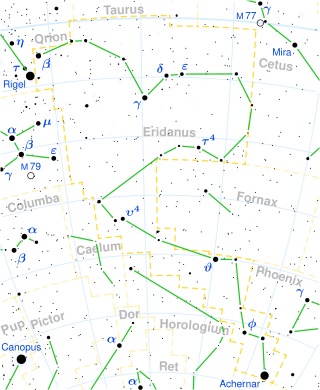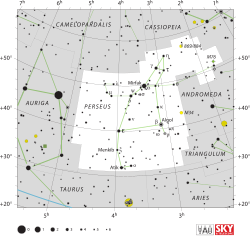
Saiph, designation Kappa Orionis and 53 Orionis, is a blue supergiant star and the sixth-brightest star in the constellation of Orion. Of the four bright stars that compose Orion's main quadrangle, it is the star at the south-eastern corner. A northern-hemisphere observer facing south would see it at the lower left of Orion, and a southern-hemisphere observer facing north would see it at the upper right. Parallax measurements yield an estimated distance of 650 light-years from the Sun. It is smaller, less luminous but hotter at its surface than Rigel with an apparent visual magnitude of 2.1. The luminosity of this star changes slightly, varying by 0.04 magnitudes.

Atlas, designation 27 Tauri, is a triple star system in the constellation of Taurus. It is a member of the Pleiades, an open star cluster (M45). It is 431 light-years away, and is 3.92 degrees north of the ecliptic.

Kappa Aquarii is a probable binary star in the equatorial constellation of Aquarius. This system is visible to the naked eye, but it is faint at an apparent magnitude of 5.03. Based upon parallax measurements made during the Hipparcos mission, it is around 214 light-years from the Sun.

Gamma Eridani, formally named Zaurak, is a variable star in the constellation of Eridanus. It is visible to the naked eye with an apparent visual magnitude that varies around 2.9, and lies at a distance of about 203 light years from the Sun, as determined by the Hipparcos astrometry satellite.

Alpha Vulpeculae, officially named Anser, is the brightest star in the constellation of Vulpecula. It is approximately 291 light-years from Earth. It forms a wide optical binary with 8 Vulpeculae.

Beta Cancri, also named Tarf, is the brightest star in the zodiacal constellation of Cancer. It has an apparent visual magnitude of +3.5 and an absolute magnitude of −1.2. Based on parallax measurements obtained during the Hipparcos mission, it is approximately 290 light-years distant from the Sun. An exoplanet, designated Beta Cancri b, is believed to be orbiting the star.

Omicron Persei is a triple star system in the constellation of Perseus. From parallax measurements taken during the Hipparcos mission it is approximately 1,100 light-years from the Sun.

Omicron Leonis is a multiple star system in the constellation of Leo, west of Regulus, some 130 light-years from the Sun, where it marks one of the lion's forepaws.
Mu Leonis, also named Rasalas, is a star in the constellation of Leo. The apparent visual magnitude of this star is 3.88, which is bright enough to be seen with the naked eye. Based upon an annual parallax shift of 0.02628 arc seconds as measured by the Hipparcos satellite, this system is 124 light-years from the Sun. In 2014, an exoplanet was discovered to be orbiting the star.
Lambda Leonis, formally named Alterf, is a star in the constellation of Leo. The star is bright enough to be seen with the naked eye, having an apparent visual magnitude of 4.32 Based upon an annual parallax shift of 0.00991 arcseconds, it is located about 329 light-years from the Sun. At that distance, the visual magnitude of the star is reduced by an interstellar absorption factor of 0.06 because of extinction.

Nu1 Sagittarii (ν1 Sagittarii, abbreviated Nu1 Sgr, ν1 Sgr) is a triple star system about 1,100 light-years from Earth. Its three components are designated Nu1 Sagittarii A (officially named Ainalrami, the traditional name for the system), B and C. A and B themselves form a spectroscopic binary. The system is 0.11 degree north of the ecliptic.

Iota Virginis is a binary star in the constellation of Virgo. Its apparent magnitude is 4.08. Based on its parallax, it is assumed to be relatively nearby, at 71.8 light-years.
Nu Ursae Majoris, formally named Alula Borealis, is a double star in the northern circumpolar constellation of Ursa Major. At an apparent visual magnitude of +3.490, it is bright enough to be seen with the naked eye. Based upon parallax measurements, the distance to ν Ursae Majoris is about 399 light-years. At such distance, its apparent brightness is diminished by 0.48 magnitudes due to interveining gas and dust.

Delta¹ Tauri is a double star in the zodiac constellation of Taurus. Based upon an annual parallax shift of 20.96 mas as seen from Earth, it is located roughly 156 light-years distant from the Sun. The system is faintly visible to the naked eye with a combined apparent visual magnitude of +3.772. It is considered a member of the Hyades cluster.

Phi Virginis is a binary star in the zodiac constellation of Virgo. It can be seen with the naked eye, having an apparent visual magnitude of +4.81. Based upon parallax measurements obtained during the Hipparcos mission, it is located roughly 118 light-years distant from the Sun.

Xi Persei, known also as Menkib, is a star in the constellation of Perseus. Based upon parallax measurements taken during the Hipparcos mission, it is approximately 1,200 light-years from the Sun.

Eta Persei, is a binary star and the 'A' component of a triple star system in the constellation of Perseus. Parallax measurements by the Gaia spacecraft imply that it is 1,000 is light-years away from Earth. At such distance, interstellar dust diminishes its apparent brightness by 0.47 magnitudes.
Pi1 Cygni (π1 Cygni, abbreviated Pi1 Cyg, π1 Cyg) is a binary star in the northern constellation of Cygnus. It is visible to the naked eye, having a combined apparent visual magnitude of 4.66. The distance to this system can be roughly gauged by its annual parallax shift of 1.89 mas, which yields a separation of around 1,700 light years from the Sun, give or take a hundred light years.

Beta Cephei is a triple star system of the third magnitude in the constellation of Cepheus. Based on parallax measurements obtained during the Hipparcos mission, it is approximately 690 light-years distant from the Sun. It is the prototype of the Beta Cephei variable stars.
Zeta Eridani is a binary star in the constellation of Eridanus. With an apparent visual magnitude of 4.80, it is visible to the naked eye on a clear dark night. Based on parallax measurements taken during the Hipparcos mission, it is approximately 110 light-years from the Sun.












